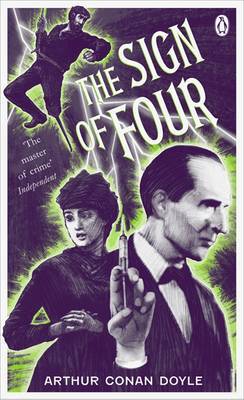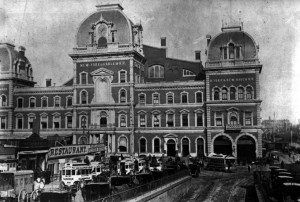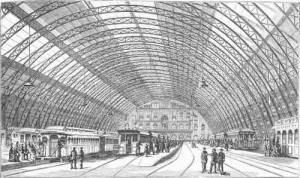With the release this month (finally!) of BBC One’s new season of Sherlock, I thought it would be appropriate to focus January’s book blog on the influence Sherlock Holmes had on the Alienist books. With numerous mentions of Holmes in interviews, plus being commissioned by the Conan Doyle estate to write The Italian Secretary in 2005, the importance of the world’s first consulting detective to Caleb Carr’s literary output is clear. But which stories were most important for the Alienist books? With such a large number of short stories and novels to choose from in the Holmes canon, it wasn’t easy to decide which story to focus this particular blog on, but in the end I decided to select The Sign of Four, the second Holmes novel, due to its very clear connections to The Alienist’s sequel, The Angel of Darkness.
What’s it about?
Sherlock Holmes is bored, and that means only one thing: cocaine, a seven percent solution. After offending Watson by deducing the history of his brother’s unhappy past from an inherited pocket watch, Holmes’ multi-week run of idleness is finally broken by the arrival at 221B Baker Street of the pretty yet plainly dressed Miss Mary Morstan, the adult daughter of an officer from an Indian regiment who disappeared ten years earlier.
Pleased that Miss Morstan’s appearance means he won’t have to take a second dose of cocaine that day, Holmes listens intently as he and Watson’s new client recounts her story involving the disappearance of her father, her receipt of anonymous gifts of large and lustrous pearls at yearly intervals following his disappearance, and a letter she received earlier that day informing her that she has been a “wronged woman” and containing instructions on how to meet her anonymous benefactor. The only evidence Miss Morstan can offer Holmes is the anonymous letter and a map with the “sign of four” marked in the left-hand corner that was found among her father’s papers following his disappearance.
As we follow Holmes and Watson in their efforts to solve Miss Morstan’s mystery, we are taken on a typically Holmesian adventure that includes late night carriage rides through the atmospheric foggy streets of London, a stolen treasure, murder by poison dart, a man with a wooden leg, a chase on the Thames via steam launch, and even a blossoming love story for Watson!
My thoughts
The Sign of Four was the second Sherlock Holmes novel written by Sir Arthur Conan Doyle, first published in 1890. Although I am a long-time Holmes fan and have read the entire canon more than once, this was my first re-read of The Sign of Four for several years and I thoroughly enjoyed my return to the world of 1880s/90s London. As with all of Doyle’s Holmes stories, The Sign of Four is a quick and easy read that lacks the florid embellishments that sometimes detract from Victorian prose. The subject matter of the story, however, is delightfully Victorian in its eccentricity. We are made aware early in the piece that a mysterious character with a wooden leg is involved in the story, and if that isn’t quirky enough, the wooden legged man also has an unusually small accomplice. As any Alienist reader will realise, it is through this accomplice that we find our first and most important connection to The Angel of Darkness.
“…How about this mysterious ally? How came he into the room?”
“Yes, the ally!” repeated Holmes, pensively. “There are features of interest about this ally. He lifts the case from the regions of the commonplace. I fancy that this ally breaks fresh ground in the annals of crime in this country — though parallel cases suggest themselves from India, and, if my memory serves me, from Senegambia.”
And:
He held down the lamp to the floor, and as he did so I saw for the second time that night a startled, surprised look come over his face. For myself, as I followed his gaze, my skin was cold under my clothes. The floor was covered thickly with the prints of a naked foot — clear, well defined, properly formed, but scarce half the size of those of an ordinary man.
Caleb Carr’s inclusion of the Filipino pygmy, El Niño, who also uses poisoned darts as one of his methods of disabling and killing his opponents in The Angel of Darkness, has been thought curious by some readers and reviewers, but he is the novel’s clearest nod to The Sign of Four’s pygmy islander, Tonga. Fun, right? However, the tips-of-the-hat don’t end there!
The Sign of Four also finds the great detective employing the services of Toby, “a queer mongrel, with a most amazing power of scent,” to assist him on the case. When Watson visits the dog’s owner, Mr. Sherman, who keeps a menagerie of creatures in his rundown lodgings, Stevie’s visit to his eccentric friend, Hickie the Hun, from whom he hires a scenting ferret in The Angel of Darkness can’t help being called to mind.
“Step in, sir. Keep clear of the badger, for he bites. Ah, naughty, naughty! would you take a nip at the gentleman?” This to a stoat, which thrust its wicked head and red eyes between the bars of its cage. “Don’t mind that, sir; it’s only a slowworm. It hain’t got no fangs, so I gives it the run o’ the room, for it keeps the beetles down.” … He moved slowly forward with his candle among the queer animal family which he had gathered round him. In the uncertain, shadowy light I could see dimply that there were glancing, glimmering eyes peeping down at us from every cranny and corner.
If that isn’t enough, the climax of The Sign of Four takes place via a steam launch chase on the Thames. Now, perhaps this one is a stretch, but the Alienist team’s employment of Torpedo boats from the Brooklyn Navy Yard to their final confrontation with Libby Hatch in The Angel of Darkness is certainly an interesting coincidence. And finally, one also can’t help wondering if even the title “The Angel of Darkness” was in any way a nod to Doyle’s first Sherlock Holmes play, “Angels of Darkness“, which went unpublished until 2000. Hmmm…
So, if you haven’t yet had the pleasure of reading any of the original Holmes canon, don’t limit yourself to the various TV adaptations. I highly recommend that you give the originals a try, and Alienist fans should find it extra fun to use their powers of observation and deduction to spot any other connections to the books!




